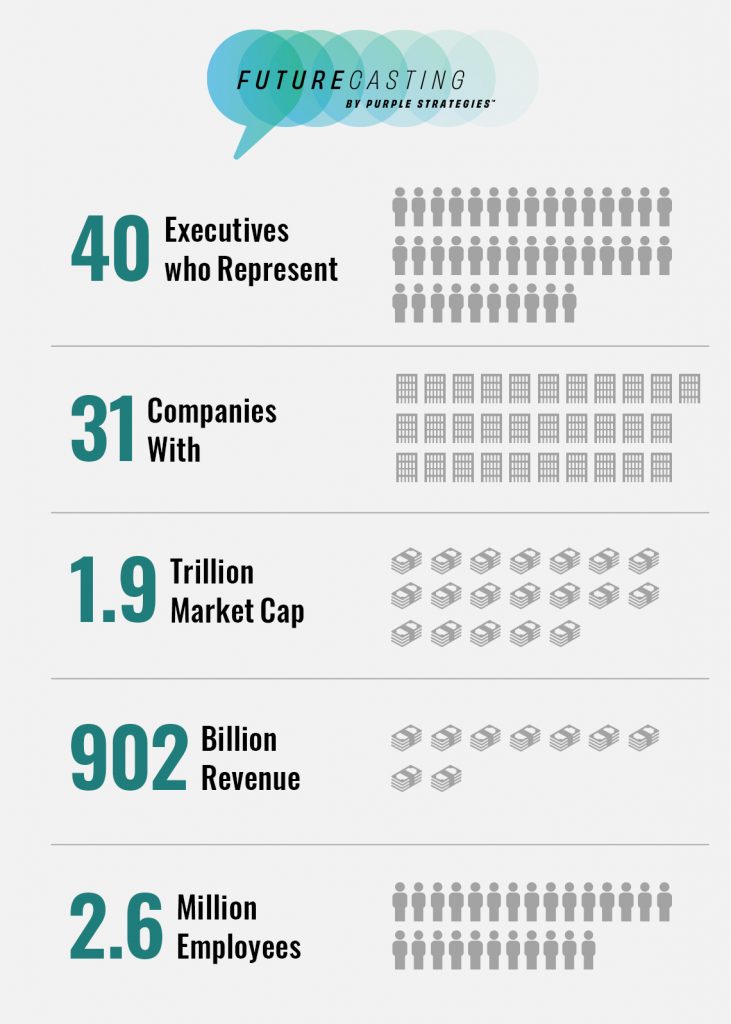Rebecca Ballard

Posted on
November 9, 2020
5 Min. Read
Author
Nicki Zink
COVID Vaccine Concerns Are Widespread Yet Partisan
Party ID & Where You Get Your News Drives Unique Factors of COVID-19 Vaccine Hesitancy
From where you grew up to where you get your news, different experiences can lead to different beliefs and opinions on important societal topics. This principle has been brought to life when it comes to how people view the coronavirus pandemic.
For example, political affiliation may lead a person to view the pandemic as a different type of crisis. Our recent research shows that Republicans view COVID-19 primarily as an economic crisis and believe re-opening should be a top priority. In contrast, Democrats view COVID-19 primarily as a health crisis and believe caution should be the guiding force, even if it is costly to the economy.
These differing perspectives can translate not just to different world views but also to different choices that have immediate impact.
One key choice that will be crucial in stopping the spread of the coronavirus is whether or not to get vaccinated, and the perceived quickness of vaccine development is becoming a liability. Just 30% of the informed public say that they are going to get vaccinated for the coronavirus as soon as a vaccine becomes available. And Republicans are more likely than Democrats to take this position.
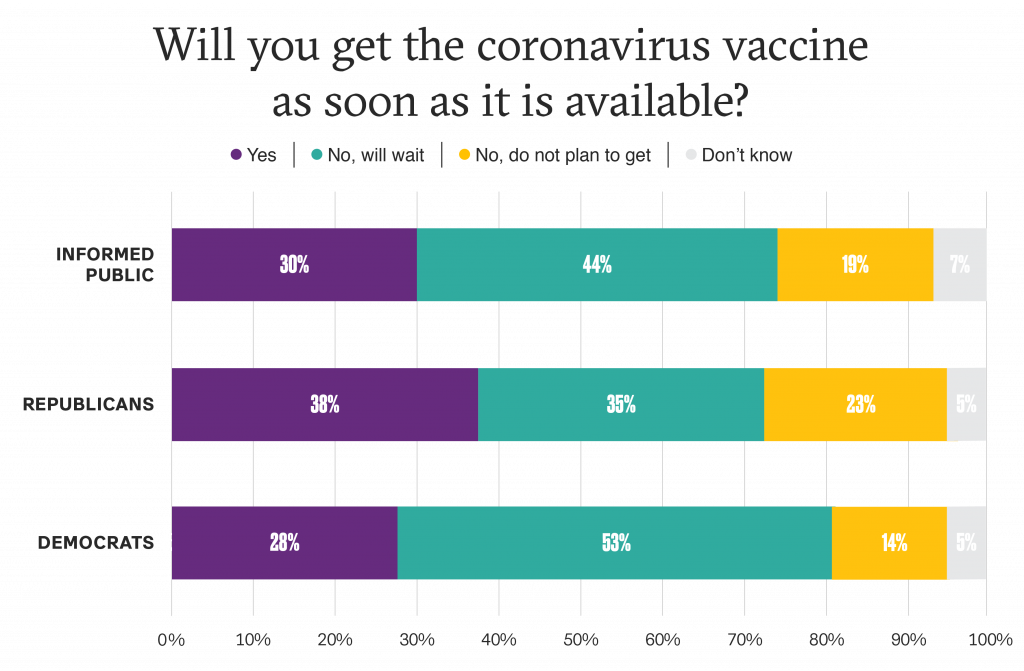
*Will you get the coronavirus vaccine as soon as it is available? SOURCE: Purple Pulse Survey of US Informed Public. N=847. September 30 – October 2.
Below we dive deeper into party identity and news consumption habits and how a person’s political party affiliation or source of news may lead to different beliefs, and then different vaccine choices based on those beliefs.
News flow on the right and left may be hurting our ability to stop the spread of the coronavirus, but for different reasons.
• On the right, there is an increased belief that coronavirus cases are going down over time, negating the need for a vaccine for some. Fox News viewers are more likely than CNN or MSNBC viewers to believe that U.S. coronavirus cases overall are decreasing week over week.
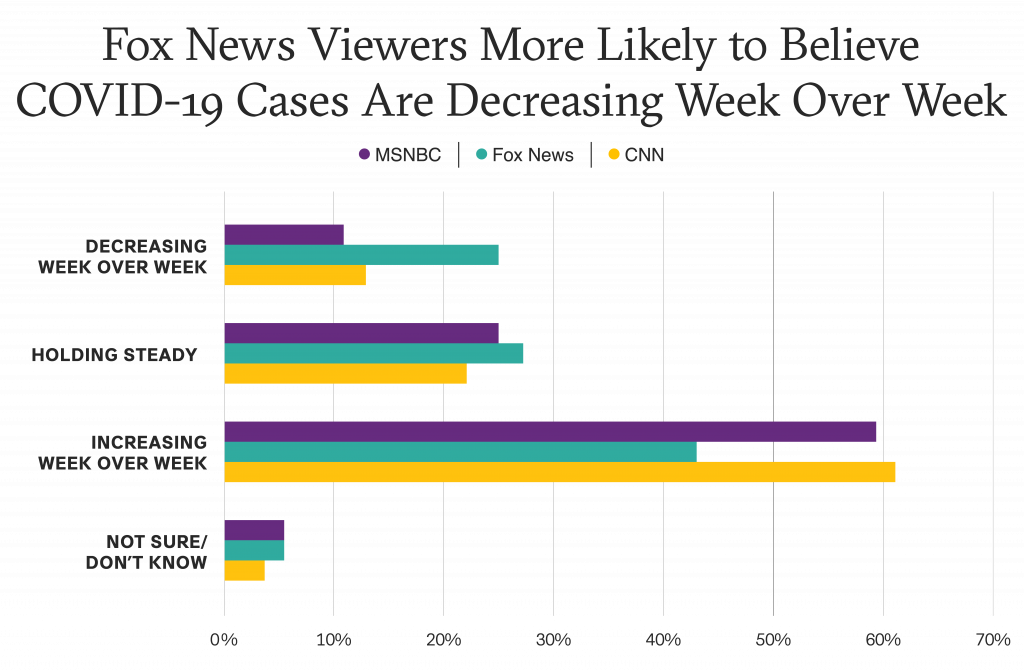
*To your knowledge, which best describes the current trend of coronavirus cases today, in your state and in the US overall? SOURCE: Purple Pulse Survey of US Informed Public. N=847. September 30 – October 2.
• On the left, coronavirus vaccine hesitancy is driven in part by concerns about the vaccine development process being rushed. Liberal cable news viewers are significantly more likely to not get vaccinated for the coronavirus if a vaccine is developed and brought to market too quickly. This view is most strongly held by MSNBC viewers, over half (57%) of which say a vaccine that was developed and brought to market too quickly would influence their decision not to get vaccinated.
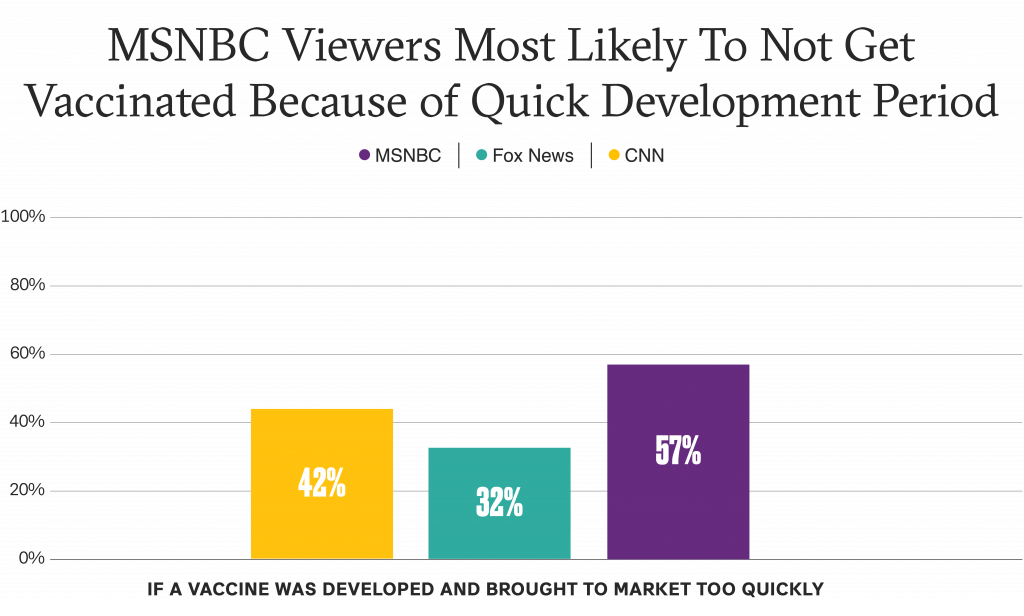
*Which of the following factors would influence your decision not to get vaccinated for the coronavirus? SOURCE: Purple Pulse Survey of US Informed Public. N=847. September 30 – October 2.
• An analysis of comments on similar Fox News and CNN Facebook posts about a coronavirus vaccine show that commenters on the CNN post express more negative opinions about a vaccine than Fox News commenters. Over 1/3 (35%) of comments on CNN’s post were critical of a vaccine compared to just 17% of comments on Fox News’ post which shared a similar sentiment. Critiques of an eventual coronavirus vaccine were multifaceted but many expressed that they did not want to get a “rushed vaccine” or be “guniea pigs.” Others proposed that conservative elected officials and their families should get the vaccine first.

Non-partisan subject matter experts are viewed with a partisan lens.
• Anthony Fauci has been a central figure to the U.S. coronavirus response and is widely regarded as the nation’s top infectious disease expert. He is frequently cited by media and referred to with similar titles by right- and left-leaning outlets. But a person’s news consumption may impact whether or not they trust him.
• CNN and MSNBC viewers are also significantly more likely to trust Fauci to say whether or not a coronavirus vaccine is safe and effective.
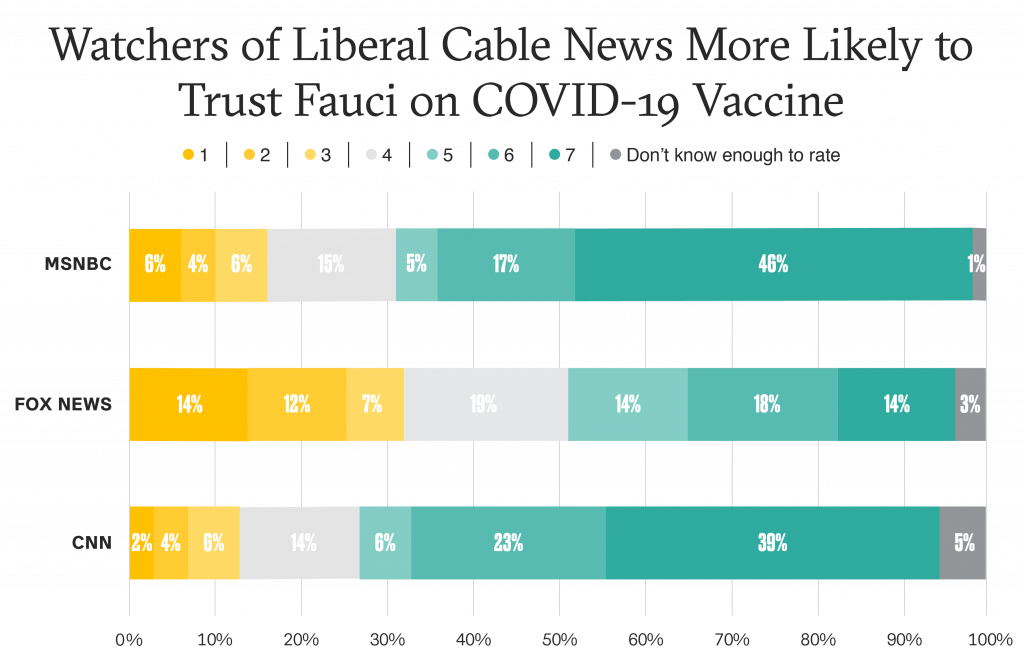
*How much do you trust the endorsement of the safety and effectiveness of a coronavirus vaccine from each of the following? SOURCE: Purple Pulse Survey of US Informed Public. N=847. September 30 – October 2.
• An analysis of comments on Facebook posts which mention Fauci and a coronavirus vaccine further demonstrate that commenters have different reactions to him. Fox News commenters are more likely to express a negative view of Fauci than CNN commenters. 618 comments (38%) on Fox’s post from September 18 are highly critical of the infectious disease expert writing things like, “he flip flops more than anyone I’ve seen,” “This man can’t be trusted,” “I wouldn’t believe a word this man says,” “I would bet he’s got a lot of stock in the company that makes it too” and “This guy tells false information he’s a liar a disgrace he’s working for democrats needs to be put in jail.” This sentiment is expressed in just 32 comments (4%) on CNN’s Facebook post.
In order to combat these varying factors driving coronavirus vaccine hesitancy, it’s important for entities in this space to meet audiences where they are.
This can be accomplished by:
• Developing a deep understanding of key audiences. In order to best engage the audiences that matter to your brand and move them to where you want them to be, it is crucial to understand not only who they are, but what they believe.
• Creating audience-specific messaging, not “one size fits all.” How you tell your story matters. Create custom messages for audiences based on their starting places in order to ensure your message resonates.
• Using a variety of surrogates to tell your story. Different voices appeal to different people. Find a variety of voices who can amplify your message and resonate with the audiences that matter to you.
By Nicki Zink | nicki.zink@purplestrategies.com
Purple is actively partnering with companies and industries to navigate the ever-changing COVID-19 pandemic and prepare for the future that will come after, bringing deep experience helping the world’s best-known companies navigate the world’s toughest challenges. Please reach out to author Nicki Zink or any member of our Purple team to let us know how we can support you.
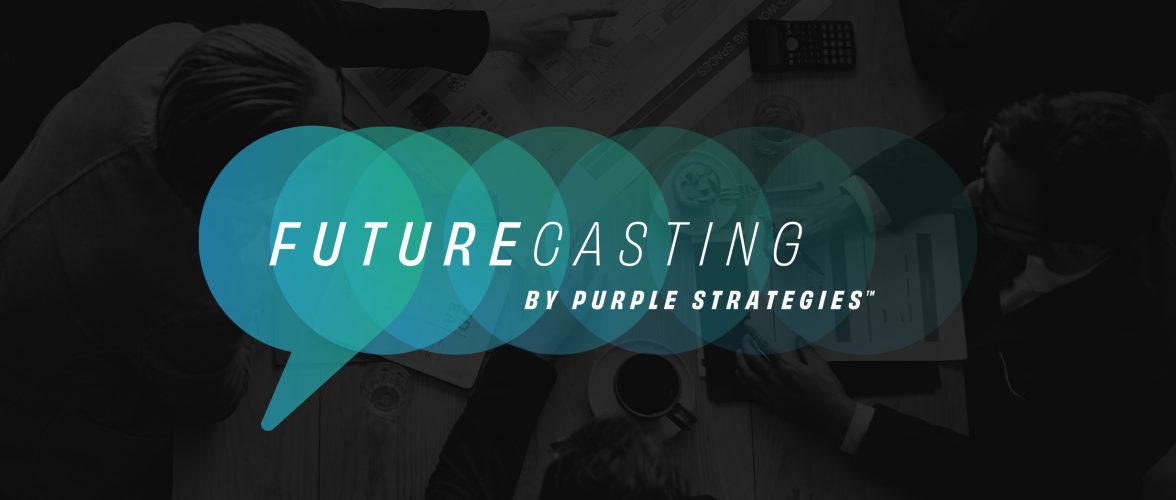
Posted on
November 3, 2020
1 Min. Read
Author
Purple Strategies
Futurecasting: The promise and peril ahead for corporate reputation leaders
Introducing our Futurecasting by Purple Strategies™ platform
A changing landscape of social, political, and business dynamics is creating a new set of challenges for business leaders. One where corporations and their hard-won reputations have as much to gain as they have to lose.
To increase understanding of this emerging era of threats and opportunities, we sat down with business leaders across industries. And asked them to identify in depth what they see on the horizon and share what their organizations are preparing to do about it.
We interviewed 40 corporate reputation leaders across large, well-known companies with billions of dollars in revenue and millions of employees. We made the interviews anonymous so these leaders could speak freely and tell us the unvarnished truth about what they are dealing with. From the more than 40 hours of interviews, Purple developed 12 insights that deal with everything from the role of the CEO, to retaining employees and attracting new talent, to the convergence of financial and reputational analysis.
Individually, their stories provide best-in-class examples of nimble and nuanced approaches to changing demands of corporate reputation. Taken together, they offer a revealing glimpse into a fascinating future that lies ahead.

Posted on
October 28, 2020
3 Min. Read
Author
Ashley Gibaldi
How pharmaceutical companies can fill the void
Reputation is often viewed as something that happens to you, not something you can actively shape. Too often, companies begin managing their reputation only when crises occur, or critic voices attract their attention.
We know that always-on reputation management can help companies manage and stay ahead of emerging reputation issues, so they don’t turn into crises. A central element of that is proactive storytelling.
When companies fail to proactively, consistently and continuously tell their story, they leave a void. And the danger then is that their critics and dissenting voices may fill that void in an attempt to take control of and determine the prevailing narrative.
Consider the pharmaceutical industry, which has been navigating intense negative perceptions for decades. There has been a consistent battle to shape the narrative around the pharma industry’s work and motives — from innovation to drug prices. The reality that public opinion on pharma is consistently lower than any other industry or business sector in the U.S. — including the federal government — isn’t new or surprising.
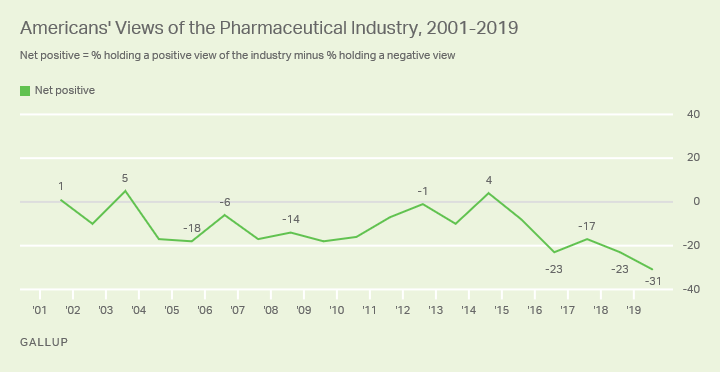
Source: Gallup
Since COVID-19 began, the pharmaceutical industry has been under a persistent spotlight. People want a vaccine. They want treatments. They want tests. And most of all, they want hope. It’s in this time – this rare moment – when the public is actually rooting for the pharmaceutical industry.
What We Saw in March
- 72% of the informed public agreed that “we should be rooting for [pharma companies] to develop a vaccine as soon as possible.”
- Almost 6 in 10 believed a vaccine would be available to the public before the end of 2020.
- The majority signaled an openness to communication from the industry during this time, as 58% said “it’s important to keep the American public informed about how companies are working to find a cure or treatment.”
Qualitative research that we have completed across a range of clients further reinforces the finding that pharma companies have permission to communicate about their progress – even if that progress is incremental and incomplete. In our research, people have told us they are looking for assurance that pharma companies are in the game and working relentlessly toward a solution.
In other words, pharma companies have a compelling story to tell, and the public is more than open to hearing it. But while the industry currently enjoys greater permission to tell its story, pharma companies will find themselves once again facing a battle to shape and control their narrative against a backdrop of heightened expectations.
What We See Today
- Expectations of when a vaccine will come to market has dramatically flipped: now a majority expect a vaccine will not be ready until 2021.
- We see a slight dip in those rooting for pharma (68%, down -4 since March), though a majority still hold this view.
- One-third of the informed public now believes that pharmaceutical companies are “taking advantage of this crisis to make profits.”
And yet, while general optimism about the timing of the vaccine and about the industry overall might be waning, the number of people who say it’s important that pharma companies keep the American public informed about how companies are working to find a cure or treatment has risen since March (62%, up +4 from March).
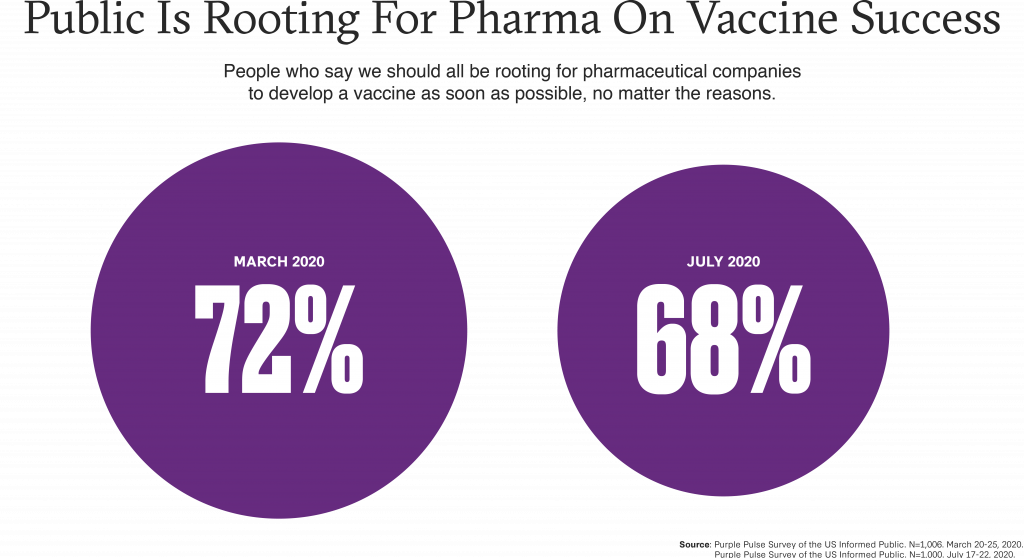
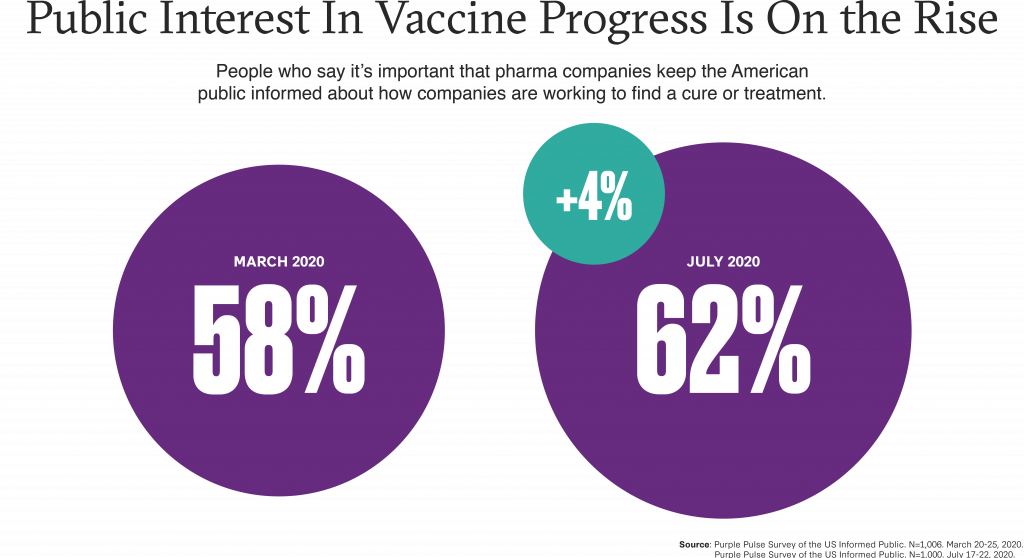
Right now, with these increased expectations, a void exists. One-third of the Informed Public has not heard about any one particular pharmaceutical company working to develop a vaccine, treatment or test, and the average recall across 15 named companies currently working on a vaccine is only 15%. And while this gap in awareness and expectations points to a void that needs to be filled, it also represents a significant opportunity for pharma companies: a majority (56%) say they would feel better about companies if they knew they were working toward “affordable treatments and vaccines to treat the coronavirus as quickly as possible.”
So what does all this mean?
It is a rare moment in time when the pharmaceutical industry enjoys both public optimism about its work and public demand to hear more about it. It is rarer still when the spotlight on this industry is not being controlled by critics intent on exposing its perceived faults. At this moment in time, the spotlight on this industry is an invitation from the public to take the stage and proactively tell its story. Pharma companies that are not actively talking about their work to make treatments and vaccines available and accessible should start. Those companies that feel they have already stepped onto the stage, likely can and should do more to rise to this moment and answer the public’s call for more information. And whether they are just starting or have been telling their story throughout the pandemic, even when they think they have said enough – they should share as much as they can to fill the void.
Purple Pulse Survey of the US Informed Public. N=1,006. March 20-25, 2020.
Purple Pulse Survey of the US Informed Public. N=1,000. July 17-22, 2020.
PURPLE PULSE SURVEY OF THE US INFORMED PUBLIC. N=847. SEPTEMBER 30 – OCTOBER 2, 2020.
By Ashley Gibaldi | Managing Director | ashley.gibaldi@purplestrategies.com
Purple is actively partnering with companies and industries to navigate the ever-changing COVID-19 pandemic and prepare for the future that will come after, bringing deep experience helping the world’s best-known companies navigate the world’s toughest challenges. Please reach out to author Ashley Gibaldi or any member of our Purple team to let us know how we can support you.
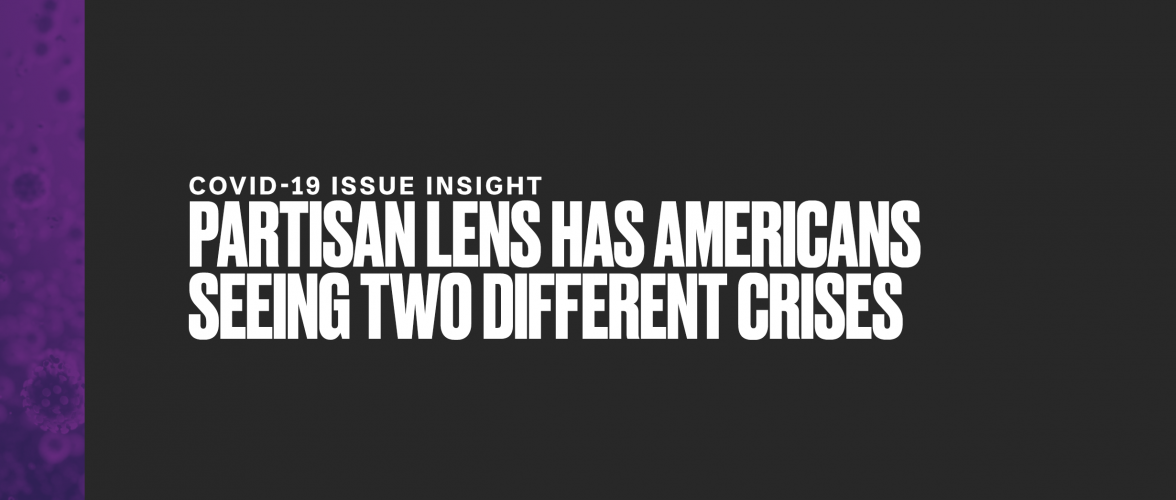
Posted on
October 8, 2020
2 Min. Read
Author
Sarah Simmons
Partisan Lens Has Americans Seeing Two Different Crises
COVID-19 Issue Insight Series | View as a PDF
Who it impacts
Companies and businesses of all sizes and sectors | Corporate leaders across the political spectrum | Anyone responsible for business planning or corporate decision-making during this phase of the pandemic
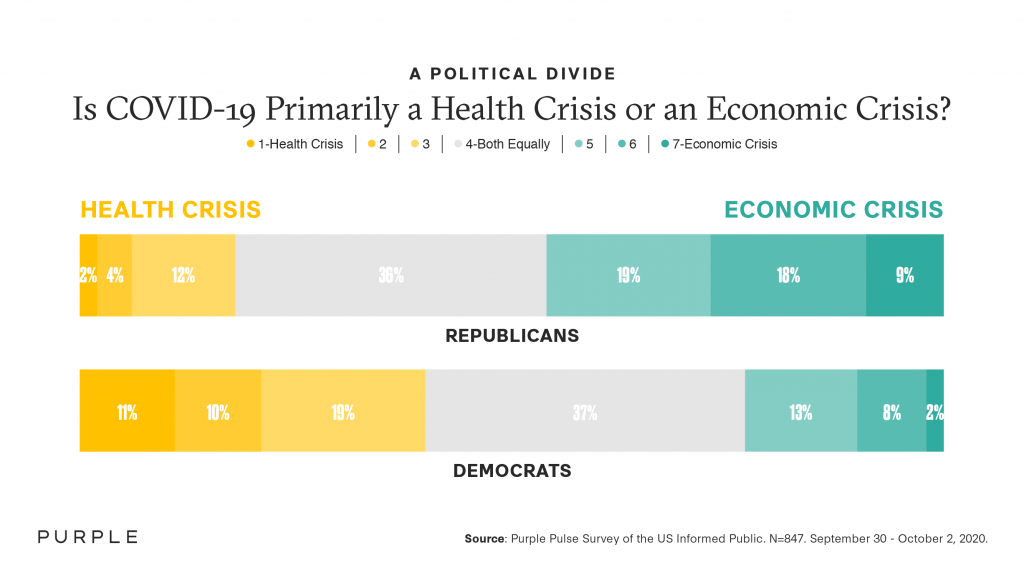
What we see
• Partisanship shapes your view of the crisis: Health v. Economic. Republicans view COVID-19 primarily as an economic crisis and believe re-opening should be a top priority. In contrast, Democrats view COVID-19 primarily as a health crisis and believe caution should be the guiding force, even if it is costly to the economy.
• Expectations are high and bipartisan for businesses to enforce safety guidelines. Regardless of party, the majority say they will stop shopping at places that don’t enforce health and safety guidelines (64% overall, 80% among Democrats, 57% among GOP). And, the majority would feel more favorable toward companies that choose to shut down in the face of rising COVID-19 cases.
Republican sentiment surrounding those safety expectations, however, is complex. Republicans are almost twice as likely as Democrats to report feeling frustrated with businesses that choose to close when they are not mandated to do so, even as the majority acknowledge an expectation that companies enforce safety guidelines (57%) and say they would feel more favorable toward a company that closes in the face of increasing COVID cases (53%). One in two Republicans (48%) say they would be frustrated if businesses choose to close if state/local guidance allowed them to be open, compared to only around 1 in 4 Democrats (28%).
• How businesses approach re-opening impacts company reputation for the long-term. Regardless of party, 60% agree that how a company handles its re-opening will have long-standing ramifications for how the public thinks about it.
What it means
Americans’ political attitudes are the filter applied to all areas of life, and the pandemic is no exception. The public is subconsciously judging companies’ opening and closing decisions through their own partisan value system and lenses. Differences such as Republicans’ increased frustration with companies “choosing” to close, or Democrats’ feeling less inclined to agree that corporate America is playing a leading role in protecting public health, are manifestations of the partisan divide on the central question of whether the pandemic is an economic crisis or a health crisis. These divisions are real and don’t just involve fringe partisans or ideologues.
Decision-makers need to be aware that their customers and stakeholders are likely to interpret how a business weighs safety considerations and economic realities as cues about whether that business leans in or out of their ideology. Attention to these cues will be critical in striking the right tone for making and communicating decisions about every phase of re-opening, including potential re-closings as the pandemic continues to unfold. A business’s actions have the potential to do damage or pay dividends today and in the future: the majority say they will stop shopping at businesses that don’t enforce health and safety guidelines and agree that how a company acts now will have long-standing ramifications for how they think about that company.
What you should do about it
• Step out of your own political bubble. Regardless of your organization’s culture or how you feel as a business executive or decision-maker, remember that the other side is out there and looking to see how you are handling these sensitive issues. Critics are likely to come from both sides: Republicans will complain about businesses closing if they can be open and Democrats will balk if they see lax enforcement of safety guidelines. Don’t decide based on fear or backlash – but out of respect for the seriousness of the situation
• Pair Health and Economic factors together in your re-opening plans. It is critical to emphasize how your re-opening plans respect health and safety guidelines and how they support the economy. Reframing to include both health and economic factors in tandem will allow your plans to reach audiences on both sides of the partisan divide.
• Communicate as more than a “check-the-box” exercise. Communicate and then re-communicate not just decisions but the rationale and considerations driving them: What is driving decisions to re-open or to close? How are you protecting the health and safety of employees and customers? When and why are you making changes? Plan to communicate as often as necessary to keep pace with the constantly evolving situation in your area. Spend the time to show how your business plans demonstrate responsibility for health and how plans are aligned with local guidance and permissions. For most of the population, enforcing guidelines respectfully will pay dividends – but framing will help to protect against objectors trying to politicize your business’s decisions.
Purple Pulse Survey of the US Informed Public. N=847. September 30-October 2, 2020.
Purple Pulse Survey of the US Informed Public. N=1,000. July 17-22, 2020.
Purple is actively partnering with companies and industries to navigate the ever-changing COVID-19 pandemic and prepare for the future that will come after, bringing deep experience helping the world’s best-known companies navigate the world’s toughest challenges. Please reach out to author Sarah Simmons or any member of our Purple team to let us know how we can support you.
By Sarah Simmons | Managing Director | sarah.simmons@purplestrategies.com
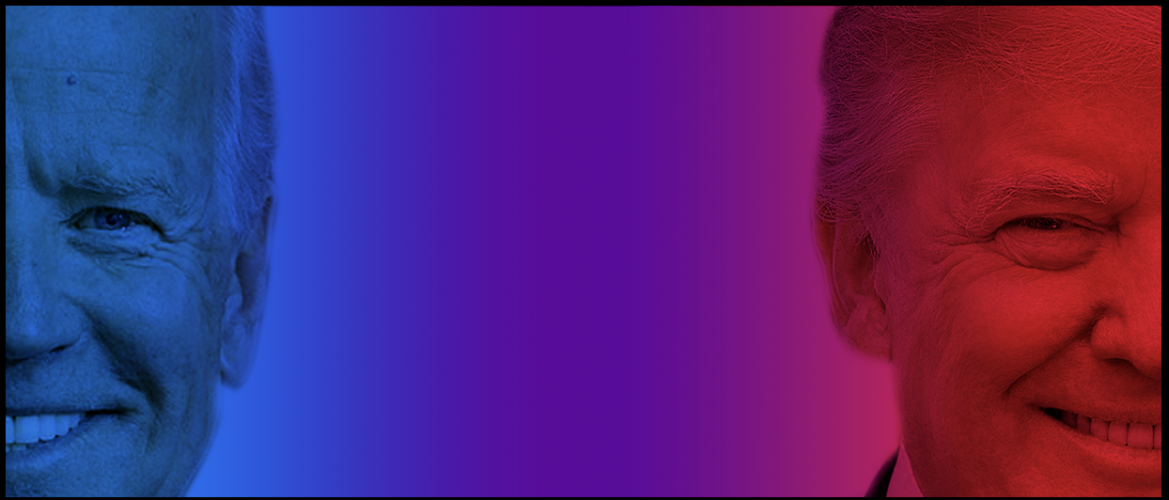
Posted on
September 30, 2020
2 Min. Read
Author
Jordan Davis and Lauren Hickey
Three Presidential Debate Takeaways For Corporate Leaders
What we see
Debate or no debate, the country is divided and people have chosen their camp.
- According to a POLITICO/Morning consult poll, prior to last night’s debate, 86% of voters report they’ve already decided who will get their vote.
- In fact, according to CNN more than 1.2 million Americans voted in advance of the debate, including a majority from competitive states.
There is a lack of empathy for opposing viewpoints and a pronounced unwillingness to engage or listen to the other side.
- A recent Pew Research Center survey found that fewer than a quarter of registered voters say they have more than a few friends who fall into the opposing party’s camp.
The debate did little to bridge this divide, nor did it provide an opportunity for the few remaining undecided voters to make an informed choice, and may have further eroded trust in our political system and government.
- According to interviews conducted by CBS News with likely voters nationwide who watched the debate, majorities from both sides of the aisle found the tone to be negative and felt annoyed after watching.
- Initial reactions from undecided voters, according to reporting by NPR, indicate that these voters remain undecided following the debate and are frustrated by what they saw.
- Whether it was the discussion around a potential coronavirus vaccine or questioning the electoral process itself, the takeaway was certainly to feel less confident in our institutions.
What it means
There’s an opportunity to fill the space traditionally held by political leaders, by seeking to unite Americans and advance faith in our country’s ability to overcome the toughest challenges ahead.
For the most part, voters’ minds are made up and their positions and beliefs stand to only be further galvanized through the rest of the election cycle. In many cases, these beliefs are deeply held. Bridging the gaps in a divided country through understanding and commonality will continue to be a challenge beyond Election Day, no matter who the ultimate winner is.
What corporate leaders should do about it
Corporate leaders don’t need to wait for an outcome of an election to begin thinking about what it means for their brand and corporate reputation. They must take an always on approach to reputation management with an insights-based understanding of their customers, employees, policymakers, interest groups, and the general public’s diverse and divergent viewpoints.
While Americans may be predisposed not to listen to the other side, our corporate leaders should be actively listening. They must make a concerted effort to get beyond group think and listen to a range of perspectives. They should ground their decisions in a research-based understanding of what’s driving sentiment and where the commonalities are that can bring us together.
America’s corporate leaders should invest their time and resources in initiatives that seek to restore trust in our institutions. Whether it’s campaigns to instill confidence in vaccine safety and efficacy or taking a stand to promote awareness and access to voting, now is the time for action. This uncertain time should be viewed as an opportunity to demonstrate leadership, trustworthiness, and competency. Reversing the erosion of trust in institutions both public and private will be critical in bridging the gaps that divide our nation.
At Purple Strategies, where we bring together Red and Blue, we know how to develop a message and activations that engage and inspire a broad spectrum of audiences. Purple is standing by to support our clients as they seek to navigate this complex landscape. Purple provides deep experience helping the world’s best-known companies navigate the world’s toughest challenges. Please reach out to authors Jordan Davis and Lauren Hickey or any member of our Purple team to let us know how we can support you.
About the Authors
Jordan Davis is a 15-year veteran of Capitol Hill and national congressional campaigns, most recently serving as Senior Advisor at the House Energy & Commerce Committee overseeing legislative and communications strategy, and prior to that as Policy Director & Communications Advisor at the National Republican Congressional Committee during the 2014 and 2016 election cycles.
Prior to joining Purple, Lauren Hickey served for five years at the U.S. Department of State, most recently as Lead Advisor for Strategic Communications. Among other responsibilities, she served as the communications point person for oversight issues, including media and congressional inquiries related to former Secretary Clinton.
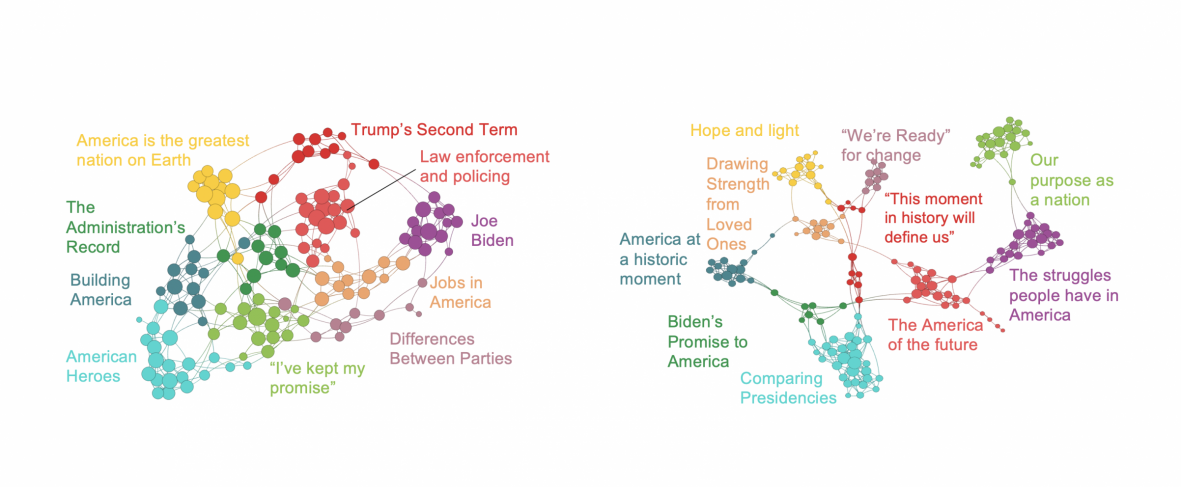
Posted on
September 30, 2020
5 Min. Read
Author
Sedale McCall
Distinct Speech Styles To Converge On Presidential Debate Stage
Two very different candidates made two distinct appeals to the American Public as they accepted their respective parties’ nominations for the 2020 presidential election, employing speech formats and structures of their own choosing. As nominees Trump and Biden prepare to step into the shared format of the presidential debate stage, we looked back at the style and structure of the candidates’ August acceptance speeches as one guide for what to watch and listen for in the debates.
The Analysis
We conducted a text analysis of each candidate’s debate transcript, utilizing a natural language processing tool that produces graphical representations of what each candidate said. These graphs visualize the statements made by each candidate, and group similar phrases and sentences together, to reveal topics of discussion and the similarities and differences in structure and theme.
We also asked two of our own political experts, Jordan Davis and Jennifer Kohl, for their take on what these data visualizations tell us about each candidate’s approach to their acceptance speech. Davis was a policy director and communications advisor at the National Republican Congressional Committee (NRCC) during the 2014 and 2016 election cycles and a legislative research director during the 2010 cycle. Kohl was the communications director for President Obama’s successful re-election campaign in Virginia in 2012, one of the top two battleground states in the country.
The Convention Speech Distinctions in 3 Visualizations
DISTINCTION IN WORDS AND MINUTES
Trump speech among longest in history; Biden speech is shortest in decades.
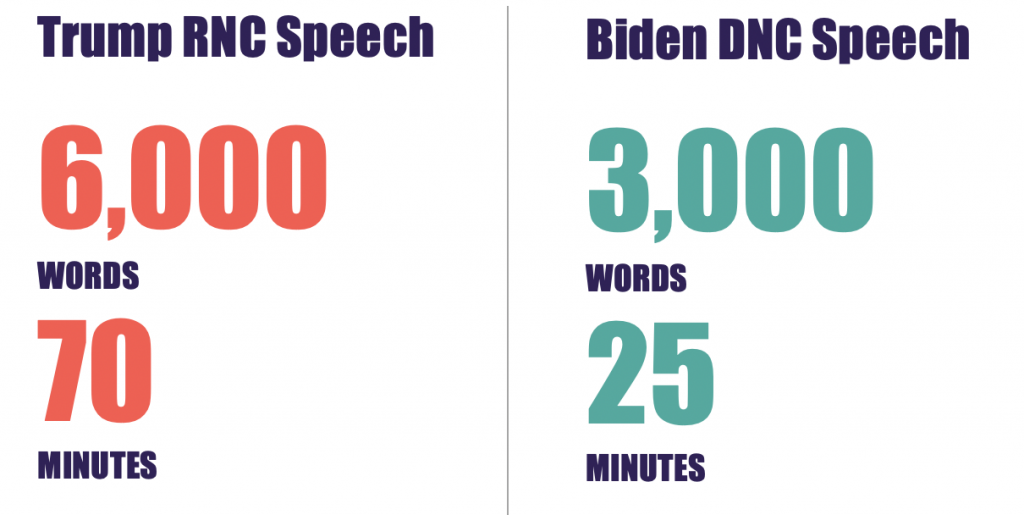
Even before either candidate uttered a word of his speech, the difference in format presented an immediate point of divergence between the two candidates. Breaking with tradition but in keeping with his preference for a live audience, President Trump used the The White House Lawn as the backdrop for delivering his acceptance speech to 1,500 people. Biden meanwhile centered a safety message in his choice of venue, taking the stage at a near-empty convention center in Delaware to deliver his acceptance speech to a virtual audience at home.
Trump’s speech took roughly three times as long as Biden’s to deliver, clocking in at just over 1 hour, compared to Biden’s much tighter 25-minute speech. In fact, Trump’s 2020 nomination acceptance was the second-longest in recent history, surpassed only by the President’s 2016 acceptance speech. Some of that length can be attributed to the live audience, but not all. The president’s speech was also twice as long as Biden’s by word count, with Trump speaking over 6,000 words compared to Biden’s roughly 3,000-word speech.
What we’ll watch for in the upcoming debates: The debate format is intended to equalize air time, but that’s not always reflected in reality. We’ll be watching for how the candidates regulate the time of their own comments, and possibly those of their opponent’s, and for how much time control is exerted by the moderators in the debates.
DISTINCTION IN TOPICAL GROUND COVERED
Trump stuck to a similar refrain throughout his speech; Biden allocated time to a variety of different topics.
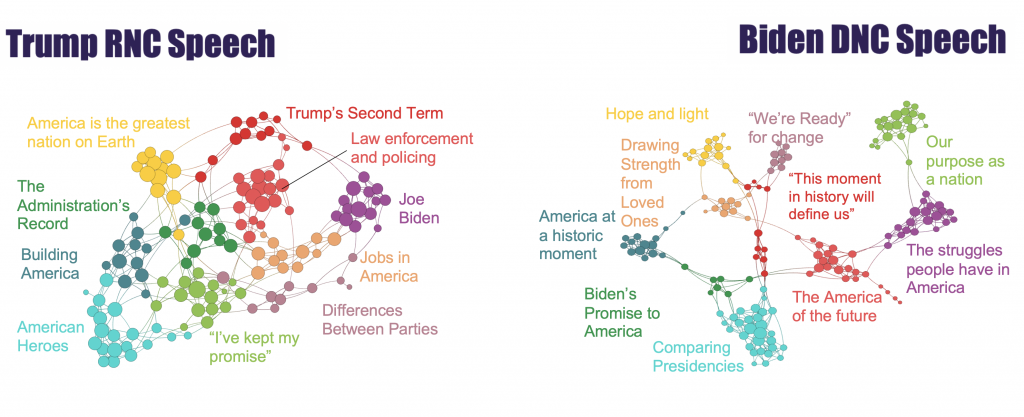
Our analysis shows that Trump’s hour-long speech covered less ground than Biden’s speech, which addressed more discrete topics in roughly one-third the time.
The graphical representations of what each candidate said feature nodes (circles) and edges (lines connecting circles) to visualize the structure and themes of speech in the graph. The closer the nodes are to each other, the more similar the conversation. Likewise, the closer a cluster (group of circles) is to other clusters, the more similar their topics are to each other.
What we see in President Trump’s graph is that all of the clusters are connected, and the nodes are relatively close to each other. This indicates that the phrases and topics Trump used are similar in nature, and that over the course of his hour-long speech, he returned to the same topics again and again. Trump primarily discussed his record or approach, using phrases like “I kept my promise,” and frequently raising issues with Joe Biden and his approach, repeating phrases like “If Joe Biden is elected…” or “The radical Left wants to… .” Compared to Biden, he spent less time laying out particular policies, and did not detail his plans for his next term.
Conversely, what we see in Biden’s graph is that the clusters are connected to only one or two other clusters and are farther apart from each other. This reveals that Biden used his shorter time to cover more ground and to discuss topics that were more diverse. In particular, Biden incorporated several different angles to introduce or provide context for the topics he covered, including discussing his relationships with his wife, Dr. Jill Biden; his late son, Beau; and his vice-presidential running mate, Kamala Harris; and outlining different and specific policy issues, including climate change, the COVID-19 pandemic, and Medicaid. Biden’s use of phrases like “hope and light,” “I see a different America,” and “we’re better than that,” added elements to his speech that were less pointed and more abstract.
What we’ll watch for in the upcoming debates: Debate topics are chosen in advance and addressed by both candidates, putting candidates in a position of having to address issues they choose to avoid in other formats. We’ll be watching the data to see the extent to which the candidates address the topics directly or revert to their chosen terrain.
“There’s a case to be made that Biden is very deliberately using a positive and diverse set of messages to appeal to a range of audiences beyond his base on issues they care about—including people who may have voted for Trump in 2016 and are now looking for a pass to change their vote this time. But anyone who has followed Biden’s life and career will know that these are more than just talking points for him. He genuinely believes in the things he’s saying; the challenge will be successfully conveying that beyond his core base to a skeptical audience.” – Jen Kohl
DISTINCTION IN DIRECTNESS OF ATTACK
Trump mounted a direct attack; Biden drew distinctions without naming names.
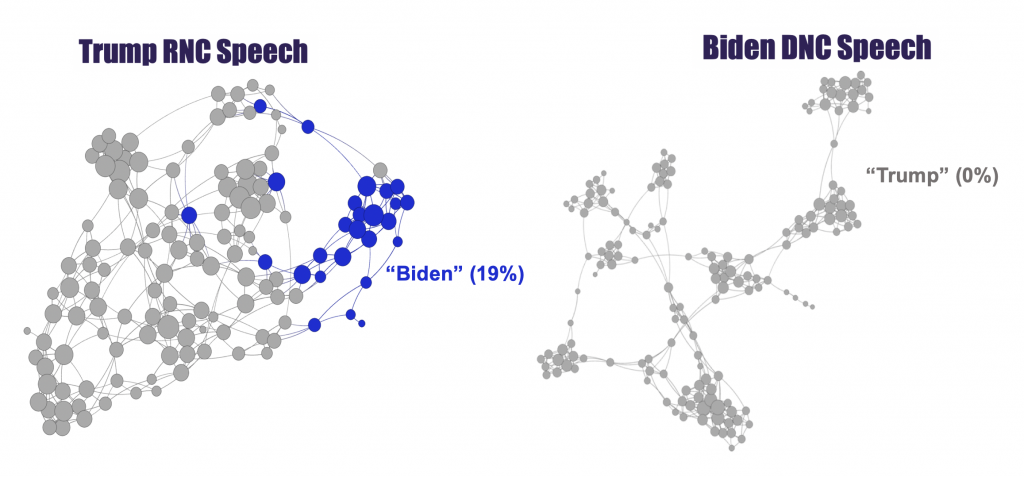
Watching and listening to each candidate’s acceptance speech, it was immediately clear that the two candidates took very different approaches to calling out the failures and dangers of electing their opponent. But the quantification of the difference between their two approaches was stark: Trump’s speech consisted of 41 mentions of “Joe Biden” or “Biden” by name. Trump repeatedly invoked Biden’s name to make his case that electing Biden and giving power to the Democratic party would lead to such outcomes as “anarchy,” “damage,” “calamities,” and “destruction.”
In contrast, Biden made zero references to “Donald Trump” by name in his speech, instead calling out the “the current president” or “the president.” While never mentioning Trump by name, Biden spoke of the role of the president to the country, comparing Trump’s administration with his vision for the role, even as he challenged the president’s record.
What we’ll watch for in the upcoming debates: Separate convention venues now give way to a single stage. We’ll be watching the data to see how each candidate attacks or draws distinctions when they are finally only a few socially distanced feet apart.
“From the convention speeches we can likely infer that Trump will go on the attack against the Biden/Harris ticket and largely pivot away from addressing policy specifics. Biden will likely take a hybrid approach, continuing to draw contrast in order to frame the election as a referendum. But he’ll also work to articulate a vision on policy matters in an attempt to appeal to diverse pockets of the electorate and their interests.” – Jordan Davis

Posted on
September 10, 2020
1 Min. Read
Author
Purple Strategies
Obama and Chef José Andrés Alum Jennifer Kohl Joins Purple Strategies
Communications strategist Jennifer Kohl has joined corporate reputation strategy firm Purple Strategies as a senior director. With experience on Capitol Hill and in political campaign, government, corporate, agency and non-profit work, she most recently led the public relations team for Nobel Peace Prize nominee Chef José Andrés and his restaurant group, ThinkFoodGroup.
“This year has put into stark relief how highly interconnected the reputation landscape has become for companies and executives,” said Steve McMahon, Purple co-founder and CEO. “Jen’s deep experience advising leaders and operating across government, politics, media, non-profits and corporations is exactly the sort of cross-disciplinary mentality our clients are seeking, and we’re pleased to have her on our team.”
In her role for the celebrity chef, she was able to marry her passion for food with her passion for communications, overseeing all public relations, earned media, and social media for José and his three dozen restaurants and 20 brands (including two with two Michelin stars each and The New York Times 2019 #1 Best New Restaurant). Prior, she worked at a progressive communications agency, where she built and led the firm’s media relations team and helped non-profit and corporate clients with crisis communications, messaging, and proactive PR campaigns for new programs and initiatives.
Jen was the communications director for President Obama’s successful re-election campaign in Virginia, one of the top two battleground states in the country. Previously, she worked as strategic communications advisor to FDA Commissioner Margaret Hamburg, on Capitol Hill for Rep. Elijah Cummings and the House Armed Services Committee, and on multiple statewide and local political campaigns.
“Purple’s campaign mindset toward the challenges facing corporate leaders is exactly the kind of thinking and strategy needed to successfully navigate today’s reality,” said Kohl. “I’m excited to join the incredibly smart and talented team at Purple in this important work seeing our clients through these turbulent times.”
Jen joins a growing Purple team that has added several senior hires to its ranks in recent months, including Rebecca Ballard, managing director for communications, marketing and engagement; Jordan Davis, senior director; Chris Dealy, executive creative director; and Stacey Jaffe, senior director and insights lead.
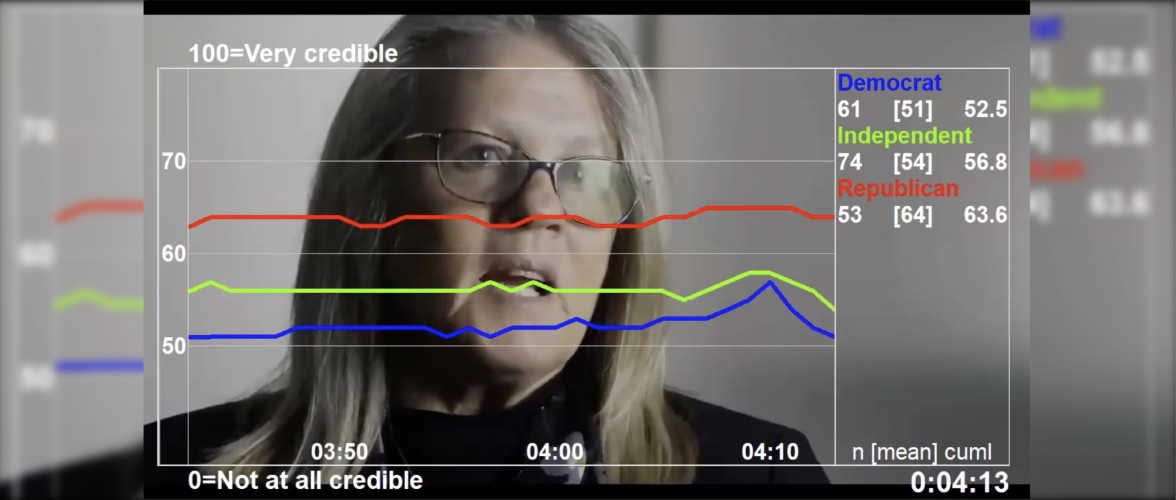
Posted on
August 6, 2020
7 Min. Read
Author
Purple Strategies
How the viral “Plandemic” video sold misinformation
Plandemic, an explosive, documentary-style video about COVID-19, spread online like wildfire. Despite its outlandish claims and obvious falsehoods, plenty of Americans were taken in by it. Because it had what so many wanted — a salacious web of conspiracy theories implicating governments, media, and public health experts — and what they needed: a story they could latch onto.
The following piece served as the basis of an Aug. 6, 2020, Purple Strategies webinar with Peter Loge, director of the Project on Ethics in Political Communication at The George Washington University, and Purple’s Denise Brien, Alec Jacobs and Meghan Moran. A recording of the webinar is available here.
Telling Stories to Explain Our World
What we know of the global COVID-19 pandemic inspires fear: millions of confirmed cases, a death toll in the hundreds of thousands, near-record unemployment, entire industries devastated. And what we don’t know suggests chaos, a world out of control: continuing questions about how the virus is transmitted and who is most at risk, uncertainty about treatments or prevention, when we can return to normalcy, or even what “normal” will mean in a post-pandemic world.
Making Sense of the World Through Stories
It’s natural that most of us are trying to make sense of the situation and navigate this chaos as best we can.
In this regard, our collective effort to process what the pandemic means and respond to it is nothing new – people strive to make sense of chaotic situations. We bring, or assert, order to our world so that we know how to function in it. The pandemic, compounded by civil unrest, political discord, climate change, and a range of other issues, makes this particular time feel more uncertain than others before it. Our urge to create an explanatory framework may be more acute than at other times. But the need itself is familiar.
One of the ways we make sense is through stories. Rhetorical scholar Walter Fisher argued that rather than homo economicus, carefully weighing pros and cons to make abstract rational decisions, people are homo narrans, relying on familiar narratives to explain our world. We identify good guys and bad guys, we assign motives, determine causes and consequences, and predict what is likely to happen next. If you strip out the details of some of the world’s most iconic stories, you’ll find many of the same core elements: a victor, a victim, and a vanquished – a heroic figure who rescues terrified villagers besieged by a dragon. Joseph Campbell, in his 1949 work “The Hero with a Thousand Faces,” describes the familiar narrative this way: “A hero ventures forth from the world of common day into a region of supernatural wonder: fabulous forces are there encountered and a decisive victory is won: the hero comes back from this mysterious adventure with the power to bestow boons on his fellow man.”
The stories we tell need not be fully accurate, but just accurate enough; facts don’t do much to inform the core of our stories. The facts matter of course, but only as much as we’re able to knit them together to help us make sense. Stories omit some facts, and others get tweaked or dialed up or down to keep the story compelling and coherent. A story can’t be entirely fictional, but it need not be entirely factual either. The story just has to be “true enough” for its listeners to recognize the kinds of tropes and motifs they expect and need to hear.
A challenge of COVID-19 and the global pandemic is that the story is an unfamiliar one. The origin of the virus is unclear, the spread is uncontrolled, the cure is unknown, the consequences keep getting worse, and the (unknown) end is nowhere in sight. That’s why our need for a compelling and comforting story is even greater. We want a story to help us make sense of the pandemic. We want a beginning, a middle, and most of all a happy ending. Just as any port will do in a storm, any story will do in a pandemic, so long as it has those familiar elements that help us make sense of things.
Enter Plandemic
In May, weeks after many Americans began social distancing and quarantining, for how long no one knew (or knows), a 26-minute video began to spread rapidly across social media platforms. In it, a filmmaker named Mikki Willis and a widely discredited scientist named Judy Mikovits weave an elaborate web of conspiracy theories, strung together with just enough of the truth (yes, National Institute of Allergy and Infectious Diseases director Dr. Anthony Fauci has worked in public health in the 1980s; yes, Bill Gates funds efforts to improve public health; yes, pharmaceutical companies aim to make a profit) to provide a plausible, cohesive narrative of the pandemic: what it is, what you should do, who to blame for it, and importantly why it’s happening. The video attracted millions of viewers before it was removed from platforms like Facebook and YouTube for containing medically unsubstantiated information.
The video has been criticized by the public health community, thoroughly debunked by a wide variety of news outlets, and described by scientists as nonsense at best, dangerous at worst. And yet, many people fell for Plandemic. Why?
Purple Strategies’ interest in this topic is not new – our firm has been studying how misinformation spreads in an effort to help our clients navigate its often-damaging impact on corporate reputation. To understand the impact and influence on those who watched Plandemic, Purple Strategies conducted online dial testing of the full video in early June 2020 – several weeks after the video first appeared and shortly after it was removed from social media sites. In addition to dial testing, which allows the viewer to provide moment-by-moment feedback on live and recorded video content, participants in this study also answered survey questions about their beliefs and reactions to claims made in the video both before and immediately after watching Plandemic.
We found that the video was successful in shifting people’s beliefs (that is, their assessment of the “facts”), even among those who found the video on the whole less than credible and those ideologically predisposed to doubt the video’s claims. And while the rest of this analysis focuses on the ways and reasons why Plandemic worked, we should note that not everyone was convinced by the video – or perhaps more accurately, not everyone found the video credible. In our testing among members of the Informed Public, more than two-thirds of Democrats and Independents, and one third of Republicans, found the video to be not at all credible or had mixed opinions. And yet, many viewers – including some of those who did not find the video credible – ended up shifting their beliefs on some crucial questions about the origin of the virus, politicization of death counts, trust in Dr. Fauci, and comfort in getting the forthcoming COVID-19 vaccine.
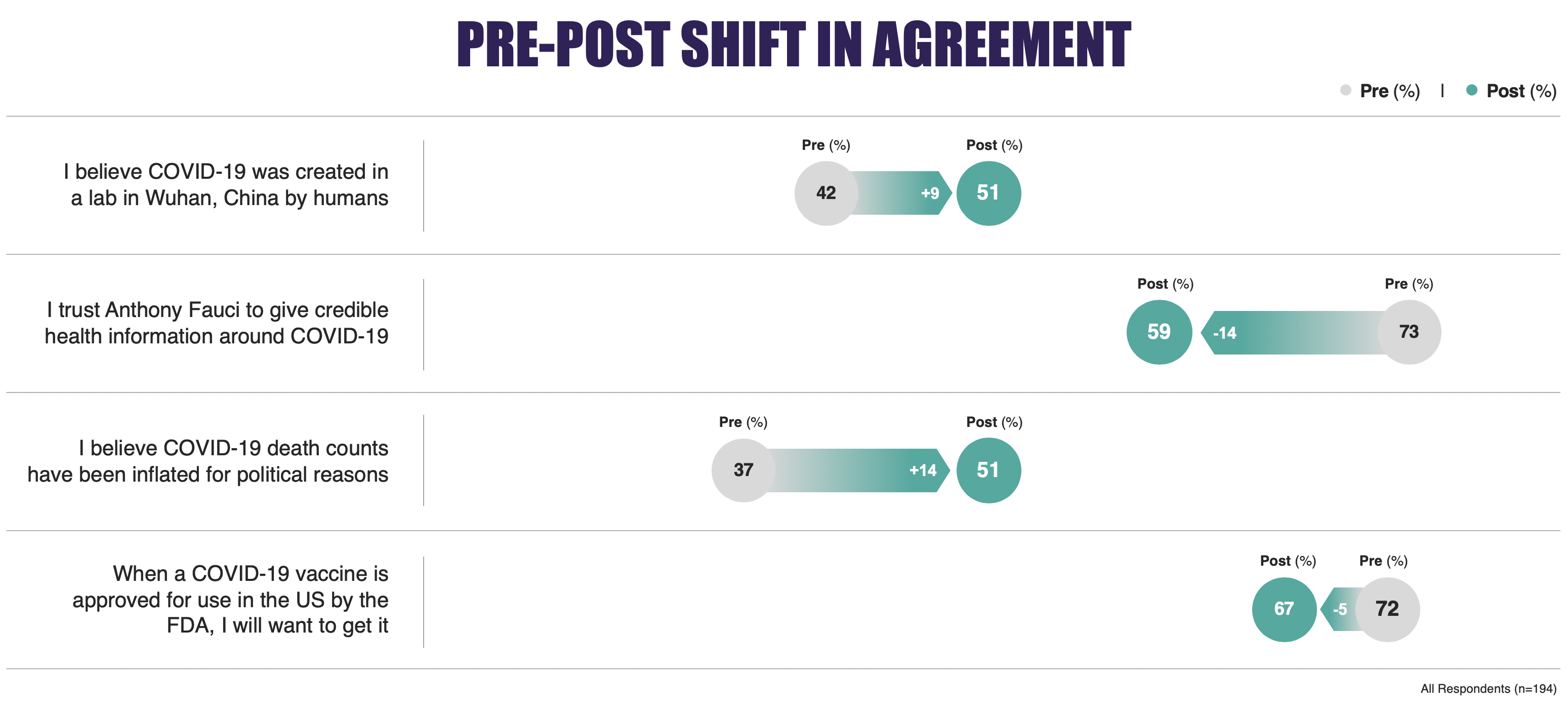 Respondents across every demographic and psychographic subgroup shifted in their beliefs on these points, including education level, party ID, age, gender, and overall credibility of the video.
Respondents across every demographic and psychographic subgroup shifted in their beliefs on these points, including education level, party ID, age, gender, and overall credibility of the video.
How Plandemic Did It
Which brings us back to, why was this video so effective? Telling a compelling story, it turns out, was key.
(1) The video cleverly contains all the trappings of a legitimate documentary. Archival news coverage and decades-old videos and photos of some of COVID-19’s key players, particularly of Dr. Anthony Fauci. A sympathetic interviewer, nodding along in solemn agreement as his subject decries all the forces that have been at work against her. Use of scientific terms and references to other pandemics (Ebola, SARS, HIV) that signal “this person knows what she’s talking about.” B-roll footage with voiceover were made to look like news reports.
Dial testing suggests that these elements work on different audiences in different ways. Among those already sympathetic to the central arguments presented in Plandemic (those whose pre-video survey responses reveal stronger agreement with claims made in the video), assessments of the video’s credibility steadily increase as each of these legitimizers play out on screen. Among those who do not start out (or for that matter, end up) as believers, and whose dials indicate that they are increasingly skeptical of what they are seeing and hearing, they nonetheless find just enough legitimate moments to prevent them from turning their dials down into “not credible at all” territory.
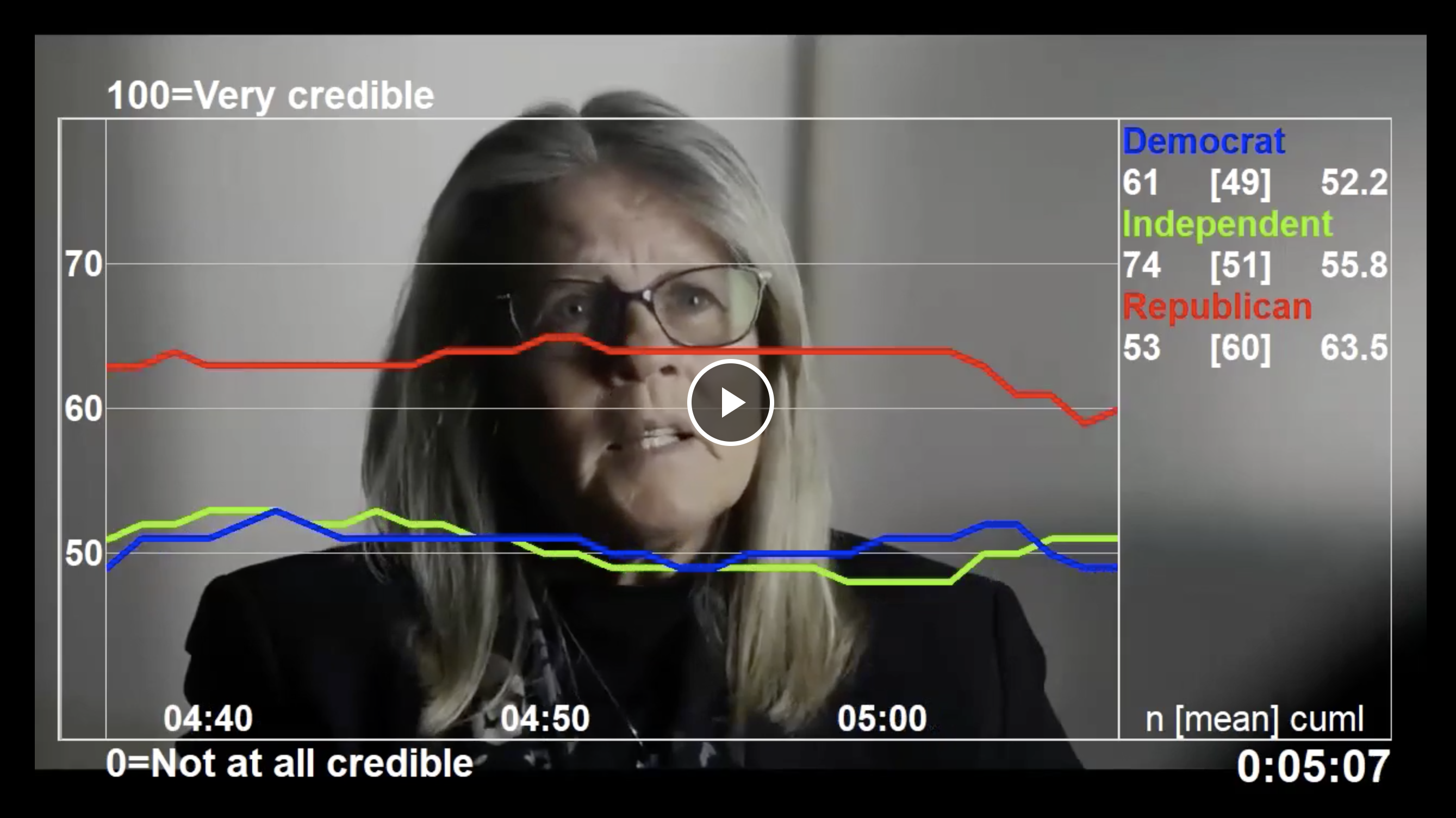
Dial testing suggests that these elements work on different audiences in different ways.
(2) As homo narrans, we humans use familiar narratives to help make sense of the world. Plandemic is chock-full of familiar narratives, and there’s a little something recognizable and believable in it for everyone. Examples of claims made in the video include:
- Scientific journals twist findings that don’t agree with the narrative of the scientific community
- Tech platforms are in on the conspiracy and working to silence “dissenting voices”
- Schools don’t receive critical funding unless they “speak the party line”
- Closing the beaches to stop the spread is “insanity” because of the “sequences in the soil” and “healing microbes in the ocean”
- Pharmaceutical companies are suppressing natural remedies and therapies for COVID-19 because they won’t profit from them; with COVID, “the game” is to push vaccines
- Makers of COVID-19 vaccines will kill millions “as they already have” (though Mikovits insists she’s “absolutely not” anti-vaccine)
- The outbreak of COVID-19 began not only in Wuhan but also in a lab at Ft. Detrich, in Frederick, Maryland, suggesting that the US military-industrial complex is partially responsible for the virus
- The government is inflating the death toll of COVID-19
- Fauci is at the center of a vast coverup conspiracy (though what he is covering up is not clearly defined)
These are effective precisely because they tap into deeply held, longstanding beliefs and reinforce familiar narratives; the sheer volume and ideological range of the claims increase the chance that everyone can find something in the video that aligns with something they already believe to be true. We know that people across demographic and psychographic groups are susceptible to misinformation, even and especially the smartest among us. Plandemic proved no exception. For those on the right, COVID-19 claims are overblown, tech platforms are suppressing the truth and China is largely responsible for the outbreak; for the left, big pharma is bad and “real” science is under attack. And for those, left or right, who are attracted to conspiracies in general, the idea that elites (in the media and science) are perpetrating a cover-up is salivating. These narratives provide just enough of a “hook” to shift people’s beliefs pre/post video on several of the video’s central claims.
(3) The video gives us the story we crave in its most traditional form. The hero — Judy Mikovits — aims to save her village — the world! — from a dragon — a “plague of corruption that places all life in danger.” Despite many trials and tribulations — Mikovits claims to have been arrested and terrorized by agents of the government and “minions of Big PhRMA,” and accuses Dr. Fauci of covering up a major scientific discovery she made — Mikovits’ “courage” to speak out helps the hero ultimately prevail. But perhaps more importantly for understanding how this and other misinformation like it succeed, the story we crave is a story, any story, that helps us make sense of that which seems to make none, providing a ready explanation of what this is, who has been wronged, who is responsible, and how we should proceed. Not everyone is convinced by this story, but that really isn’t the point. The real, accurate story is messy – doctors, nurses, and public health officials striving to figure out the virus, treat it, and cure it against a backdrop of conflicting messages about transmission and prevention. The true story lacks the clearly defined narratives and roles we crave – victor, victim, vanquished. Plandemic provides those comfortable tropes.
“I find it what we need to hear. We always need to question what we’re being told. The content of this doesn’t surprise me.”
“I have seen this video before and shared it on social media as I thought there was good information to share. I was told that the scientist was fake and her research is discredited and not valid. However if people do not want information shared they cover it up. We all need to research information that we read and hear and not take things for face value.”
“The lady sure appeared sincere, knowledgeable, and credible. There are some folks that need to be required to answer some really tough questions.”
“I am so glad I saw this video and I find it very credible, interesting and educational. It is scary how our government can hide things and control people and situations in cases like this.”
(4) The video trusts us to make the right decision with the “truth” it has revealed to us. People don’t want to be told what to believe. They want to make up their own minds and come to their own conclusions. The creators of Plandemic lay out plenty of “facts” and the story they’re telling is clear, but they stop short of telling viewers exactly what to believe or how to act. This is especially important because we know how severely it can backfire when people are told what they should believe. The last question of our survey showed people a disclaimer informing them the video they had just watched was removed from social media sites for containing misleading information and asked how credible they found it knowing that. It turns out that the disclaimer didn’t shift people’s overall assessment of the video’s credibility, and open-end responses suggest that knowing that the video had been taken down actually caused some respondents to find it more credible. Though they were attempting to do the right thing, this move by social platforms actually increased resistance and skepticism, lent further credibility to the idea expressed in Plandemic that the actual truth was being hidden.
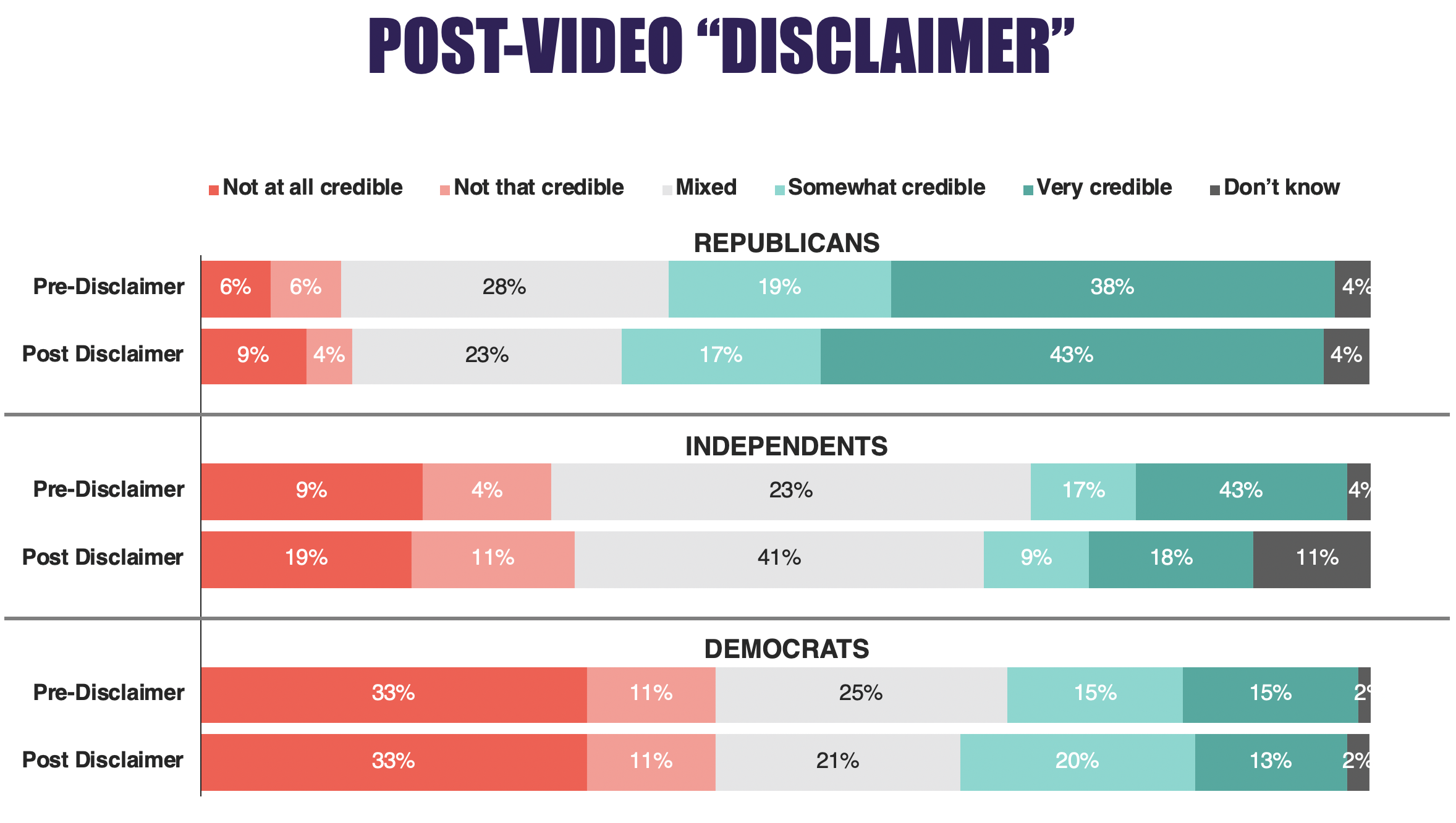
Q: In light of the information that social media platforms removed this video from their platforms because it included unsubstantiated medical advice, how credible do you find the information shared in the “Plandemic” video?
How to Fight Back
Immediately after Plandemic was posted online, multiple media outlets and critics (with arguably far more credibility and bona fides than the protagonist of Plandemic) mounted a spirited rebuttal, offering point-by-point takedowns of the factual inaccuracies in the video. Their intentions were good: correct the record and provide people with more accurate information so they can make better decisions and come to more informed conclusions. And while there has been some scholarly debate about how well that works, recent research has shown that fact-checking can work to sway people’s beliefs in the direction of new, more accurate information.
But countering a conspiracy theory requires more than facts and fact-checking – it also requires its own compelling narrative. Disputing a conspiracy theory fact-by-fact can help weaken its credibility, but without a supporting story that presents accurate information in a compelling narrative, it will usually lose. Good advocates provide accurate information with the contents – the narrative – to help make sense of complex and sometimes evolving facts.
What this suggests is that to counter misinformation, we need a more compelling counter-story. And in this respect, Plandemic offers valuable lessons for all of us:
• Meet people where they are. Attempting to change people’s beliefs (assessment of the facts) and ultimately their attitudes (underlying position on a topic) requires first understanding their starting positions and beliefs. Too often, fact-checking makes the mistake of assuming that people are looking for truth, when more often they are looking for confirmation and validation; too often counter-arguments jump to the “right answer” without considering the barriers many will have in making such a leap. Moving people to another position often requires an incremental approach that recognizes where they are now in terms of their beliefs and plans the steps (including new information) it will take to bring people along.
• Tell a story. Facts and rebuttals may be the basis for the story we want to tell, but they cannot themselves be the story. A list of facts is not a story. Critical facts must be woven together into a story that makes sense of the chaos and confusion. They must offer a better port.
• Use narratives that give people something familiar to latch onto. Particularly in stressful and uncertain situations, we seek out the familiar to comfort us. Plandemic deftly employs familiar narratives that speak to different audiences at different starting points, giving just about everybody at least something they can nod along with.
• Find the right storyteller. Perhaps the biggest challenge for those looking to combat misinformation is that they are so often missing a compelling and credible voice to tell their story. With the increasing politicization of science, hyper-partisanship in politics, and the active and increasing distrust of companies and institutions, this is not an easy task. And it is made even more difficult by those who spread mis- and dis-information, who typically look to discredit messengers of truth as a first step. Dr. Fauci might have been well-positioned to tell a comprehensive story about the pandemic and how we can eradicate it; the filmmakers’ direct and repeated attacks on him were certainly no accident. Scientists are often called on to rebut inaccuracies, but can make for less than compelling messengers by virtue of the self-restraint imposed by their ethical and moral responsibilities and obligations to the scientific method and the communication of scientific findings. They may make good messengers, if they can communicate authoritatively and responsibly in a way that is still compelling.
• And finally, guide people toward the truth but let them come to their own conclusions. Attempts to force people to accept a particular belief or story as true often backfire. People trust themselves to sort through evidence and reach the right conclusions much more than they trust others. The decision about what to ultimately believe and accept must be theirs. Unfortunately, this kind of encouragement to “decide for yourself” often takes the form of telling people to question everything and to not accept anything as true until they’ve done their own research, which is what leads many down conspiracy theory rabbit holes to begin with. But by supplying people with the facts they need woven into narratives they’ll recognize and accept as legitimate, and guiding them toward trusted sources for affirmation, we’ll have done what we can to help people come to sound conclusions.
Denise Brien | Managing Director | denise.brien@purplestrategies.com
Alec Jacobs | Senior Director | alec.jacobs@purplestrategies.com
Peter Loge | Associate Professor, School of Media and Public Affairs, The George Washington University | biography
Purple is actively partnering with companies and industries to navigate the impacts of misinformation and disinformation, bringing deep experience helping the world’s best-known companies navigate the world’s toughest challenges. Please reach out to authors Denise Brien or Alec Jacobs or any member of our Purple team to let us know how we can support you.
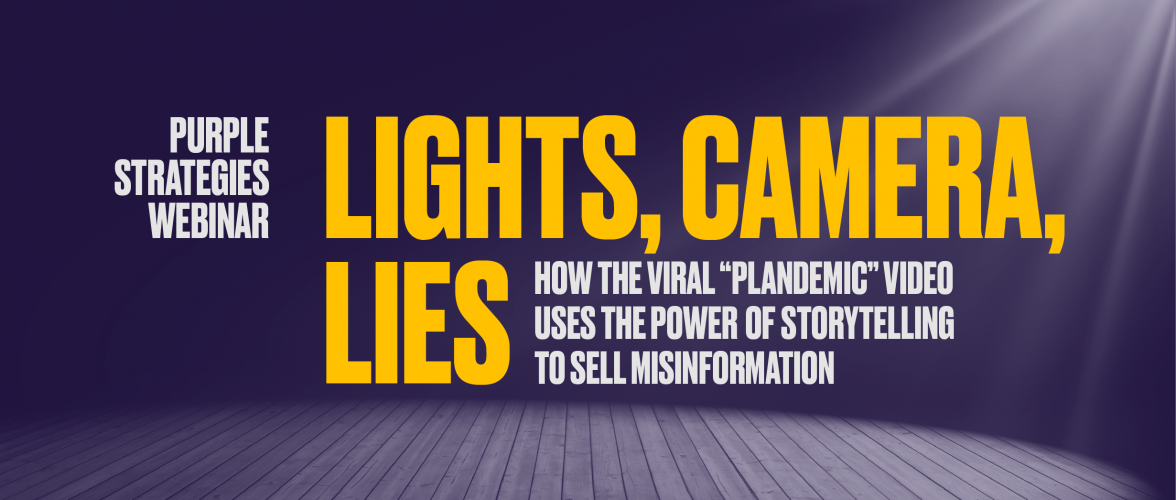
Posted on
July 29, 2020
1 Min. Read
Author
Purple Strategies
WEBINAR: How the viral “Plandemic” video uses the power of storytelling to sell misinformation
Despite its outlandish claims and obvious falsehoods, plenty of Americans were taken in by Plandemic: an explosive, conspiracy-laden, documentary-style video about COVID-19 that appeared on social media in May. We dial-tested the viral video to find out how it was so persuasive. Watch Peter Loge, director of the Project on Ethics in Political Communication at The George Washington University, and Purple’s Denise Brien, Alec Jacobs and Meghan Moran to discuss our findings on why Plandemic was so compelling to so many, and how best to combat the kind of dangerous misinformation it represents.
Dive into our full findings and insights here.

Posted on
July 20, 2020
3 Min. Read
Author
Nate Byer
Be Ready to Burst the NBA Bubble
If there’s one thing we do well in America, it’s argue. Especially about politics. Taxes, healthcare, the environment – on pretty much any topic, it’s a fair bet that about half of Americans will happily disagree with the other half. But sports has always been different.
Despite increasingly divergent opinions on the intersection of political activism and our national pastimes, the love of competition on the professional playing field, court, or rink has been something we come back to in times of challenge. Sports represent a fun and safe place to connect, and yes argue, with family and friends. Or at least it used to be.
As COVID-19 infections continue to surge across the country, the pandemic is creating new political and social flash points around what it means to play ball.
For the NBA, a league that has invested heavily in bringing players to Florida for the July 30 season restart, the challenge of playing indoors in the midst of the crisis is particularly pointed. In March, the NBA’s move to postpone the 2020 season after a single player tested positive was a bellwether of things to come. Their early, decisive action was brave and sent a message about the value of player and fan safety.
But now, in the midst of rising infection rates, beliefs among fans as to how the league should move forward are fractured. One in four sports fans are already against the NBA’s decision to restart the season and only 16% of fans think the league should move forward if players start to test positive inside the NBA’s “bubble.”
Half of fans say the league should cancel the final set of games if players start to test positive, full stop.
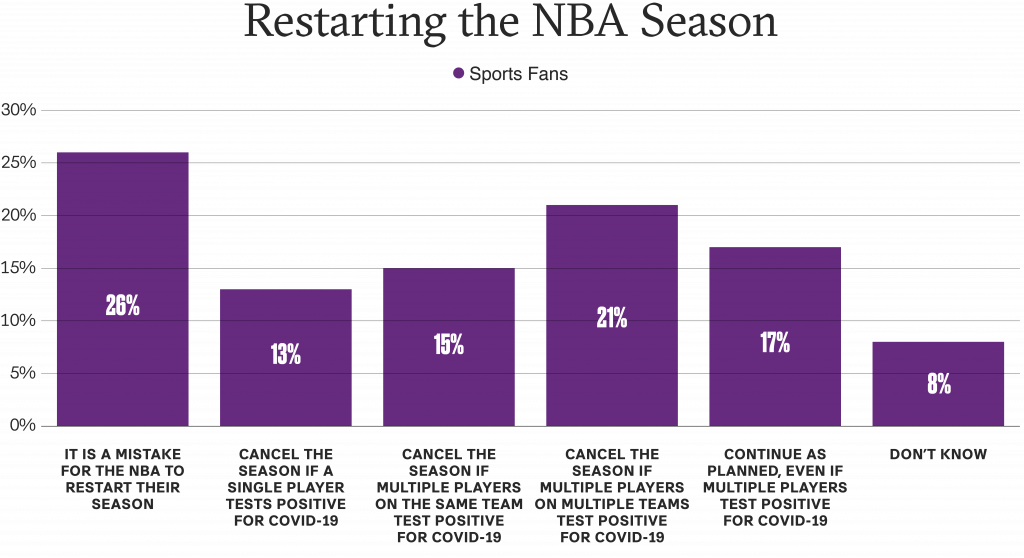
What’s underlying this concern seems to be two widely held beliefs: first, 73% of fans say that looking back, the NBA’s decision (and those of other leagues) to pause play was the right move; and second, 65% say players, despite being paid between merely huge and hugely massive sums of money, shouldn’t have to play if they have concerns about the virus. Only 29% of sports fans say players should have to lace up.
The reality is that the NBA is riding high on its positive reputation right now, despite the much maligned “bubble meals.” Fans are bullish on the league’s future (45% say its best days are still ahead!) and its reputation for deftly navigating social issues is the envy of every other league, including the NCAA. In April, The Boston Globe noted “The NBA is the only [league] trusted to do the right thing, whatever that happens to be, largely because Adam Silver is the most competent and compassionate commissioner in sports. It’s not close, really. He’ll be worthy of our trust when sports return and normalcy begins to be restored.”
And yet here we are in mid-July, staring down many of the same challenges we faced in April. The virus is surging and hospitals in some parts of the country are at a breaking point. In many ways, we’ve willed an opening that we weren’t ready for, and the NBA is doing everything it can to toe the line with its own. Every industry and business is facing this challenge of the public wanting something we might not be ready for, but probably nowhere is it more easily visible than with sports. Non-sports fans are nearly 60% more likely to think restarting the NBA right now is a mistake.

Adam Silver should tread carefully to protect his and the league’s reputation equity in the coming weeks. In March, he pulled the ripcord and quite literally saved lives while strengthening the NBA’s reputation. Being brave enough to ignore the sunk costs of the restart if players start testing positive will cement beliefs about the league’s values, deepen trust in its leaders, and accelerate the NBA’s aspirations to become the leading American sport of the future.
Purple Pulse Survey of the US Informed Public. N=800. July 1-2, 2020.
By Nate Byer | Managing Director | nate.byer@purplestrategies.com
Purple is actively partnering with companies and industries to navigate the ever-changing COVID-19 pandemic and prepare for the future that will come after, bringing deep experience helping the world’s best-known companies navigate the world’s toughest challenges. Please reach out to author Nate Byer or any member of our Purple team to let us know how we can support you.
 Fake ads, real damage
Fake ads, real damage  AI and Paradigm Shifts on the Minds of Healthcare CEOs
AI and Paradigm Shifts on the Minds of Healthcare CEOs 